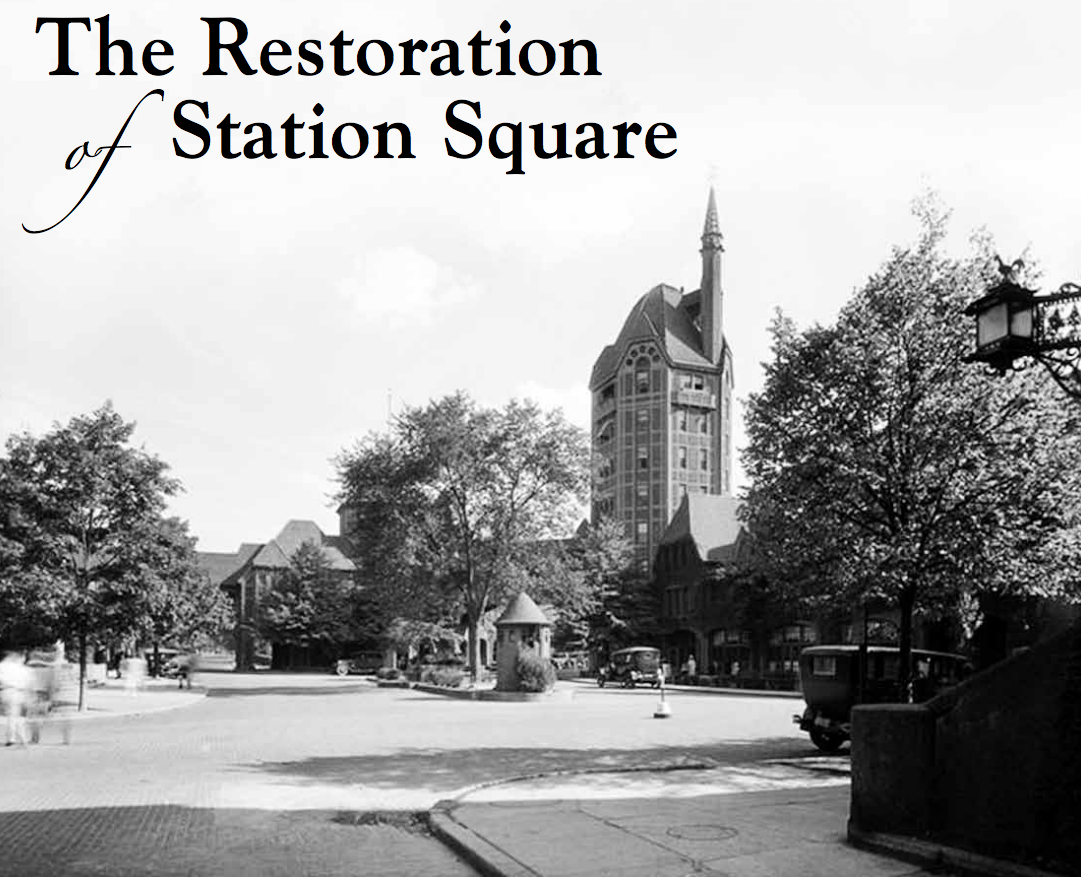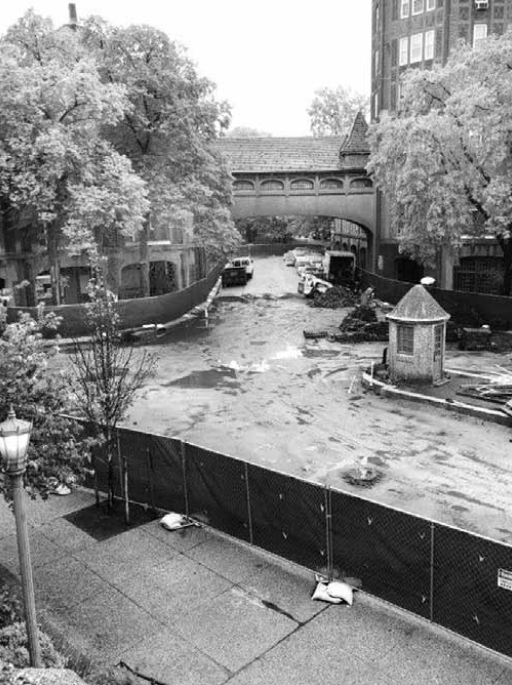The Restoration of Station Square

By: Maureen Shillet
As we are all acutely aware, Station Square, once described by architectural historian Robert A.M. Stern as “one of the finest public spaces in America,” is being restored to its former glory. Certainly, the closing of the brick-filled hub to all vehicular traffic has caused some disruption in our usual patterns, and has exacerbated the traffic logjam on Continental Avenue (71st). But the project, which is projected to be completed before the end of the year in time for our community’s traditional holiday festivities, will be well worth the inconvenience. The reality is that if this project was not undertaken now, the beautiful gateway to Forest Hills Gardens, as designed almost 100 years ago by Grosvenor Atterbury and Frederick Law Olmsted Jr., would be lost forever. The concrete base is collapsing, and would continue to collapse, causing the unsupported bricks to further deteriorate. Goodbye red brick road as we know it. But to the rescue came a windfall that made the long-discussed restoration a reality.
Four years ago, Queens Assemblyman Andrew Hevesi secured a significant grant for Forest Hills Gardens Corporation specifically earmarked for the restoration of Station Square and the bricks. At around the same time, Jose Bruguera, an award-winning architect and partner in the highly-regarded Pei Cobb Freed & Partners architect firm, founded by I.M. Pei, joined the board. He and former FHGC President Mitchell Cohen have been front and center in moving the project forward. Nearly two years ago, the first step was to hire a civil engineering firm to design the new square and prepare the construction documents. After bidding out the job to four firms, a finalist, Thornton Tomasetti was chosen. This is an extremely complicated project because it not only involves restoring the bricks and concrete road bed, but also coordinating and overseeing the upgrading of the utilities under the plaza (including replacing a section of water main and laying new gas, phone and electrical lines). After seven long months of negotiation with the Department of Environmental Protection by Jose, Mitchell and Thornton Tomasetti, the DEP finally agreed to pay for the water main, one of the costliest elements of the project. In fact, National Grid, Con Ed and Verizon also agreed to bear the cost of upgrading their equipment. National Grid will be laying new high power gas lines which will extend beyond Station Square to the surrounding streets as part of a city-wide upgrade. Finally, the utilities had to secure permission from the Long Island Rail Road. Did I mention this was complicated?
Another hold up was finding replacement bricks to match the nearly 100-year-old ones found in Station  Square. The goal is to save and reuse as many of the original bricks as possible. They will be taken up, cleaned, brushed and stored and ultimately re-set. Replacements will be needed however, and finding reclaimed bricks with the same density, size, height, color and age proved to be nearly impossible. This has been made more difficult as the original manufacturer in Payton, Pennsylvania is long out of business. Jose conducted a time-consuming, extensive, nationwide search, but couldn’t find a suitable match until he finally found a company in Buffalo with identical bricks reclaimed from a street in Boston. Fortunately, this company had sufficient quantities not only for the restoration but for future needs as well.
Square. The goal is to save and reuse as many of the original bricks as possible. They will be taken up, cleaned, brushed and stored and ultimately re-set. Replacements will be needed however, and finding reclaimed bricks with the same density, size, height, color and age proved to be nearly impossible. This has been made more difficult as the original manufacturer in Payton, Pennsylvania is long out of business. Jose conducted a time-consuming, extensive, nationwide search, but couldn’t find a suitable match until he finally found a company in Buffalo with identical bricks reclaimed from a street in Boston. Fortunately, this company had sufficient quantities not only for the restoration but for future needs as well.
With construction design plans in hand, utilities on board and funded, and replacement bricks identified, the FHGC solicited bids for the restoration work. The FHGC ultimately selected Boccia, who specializes in restoration of masonry and has done other work for the Gardens Corp. They were willing to work with the utility companies and proved to offer the best combination of fit and price. The civil engineering firm, Thornton Tomasetti, will provide project management as well as project administration. As with any major undertaking, “it takes a village,” and Jose assembled a diverse committee of active contributors including FHGC board members Fouad Bedouin and Victor Longtin, as well as representatives from Upkeep, the Architectural Committee, and the Traffic Committee. For instance, the Traffic Committee is dealing with the Long Island Rail Road pick-up and drop-off problem created by the square’s closing. It was also important for Community Relations to keep local organizations apprised of construction plans, and thus informational meetings were held with the local 112th Precinct, Queens Borough President Melinda Katz’s office, Forest Hills Stadium Concert Promoters, Friends of Station Square and other local groups affected by the disruption.
Continental Avenue (71st) has been kept open by removing the bricks in thirds, keeping one lane open in each direction 24/7. To date, most of the bricks in Station Square have been removed. The plan is as follows. The concrete base will then be demolished, utilities will be installed on a coordinated schedule, a new concrete base will be poured, and finally and perhaps most importantly, the bricks will be painstakingly re-laid exactly as it was done 100 years ago. Unfortunately, FHGC does not have the original architectural plans. They reside at Cornell University in Ithaca, NY. But using a drill test, a survey, and original photos and drawings, Thornton Tomasetti determined exactly how the bricks were laid during original construction. The bricks will be set in sand, as they were originally, as cracking would occur otherwise. They will also be re-laid in the original Union Jack pattern. A series of photographs will be taken during construction for the historical record.
Clearly, the restoration of Station Square is a massive and very necessary undertaking of historical importance to preserve the integrity of the gateway to Forest Hills Gardens. But without a strong, committed Forest Hills Gardens Board, government funding, and the strong support, patience, and understanding of the local community, this project would not have happened. Remember, it takes a village.
